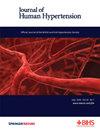Population-based surveillance for hypertension awareness, treatment, and control in nine districts - India Hypertension Control Initiative, 2018–19
IF 3.4
4区 医学
Q2 PERIPHERAL VASCULAR DISEASE
引用次数: 0
Abstract
Hypertension control is the crucial indicator for cardiovascular disease programs. We conducted a baseline cross-sectional survey to estimate hypertension awareness, treatment, and control in the selected districts in 2018–19, where the India Hypertension Control Initiative is being implemented. We conducted cross-sectional surveys in nine project districts for 18–69 years age group. The sample size was 624 per district. The study population was individuals with raised BP/diagnosed HT. We estimated the proportion and 95% confidence intervals (CI) for each district’s awareness, treatment, and control. We computed unadjusted and adjusted prevalence ratios (APR) with 95% CI for factors associated with BP control. Hypertension was defined as systolic blood pressure (SBP) > = 140 or diastolic blood pressure (DBP) > = 90 mmHg or treatment in the previous two weeks. Control was defined as SBP < 140 and DBP < 90 mmHg. Among 7047 who had hypertension, 52.4% were aware, 40.8% were on treatment, and 14.5% had BP control. BP control was below 5% in two districts, 5–15% in three districts, and more than 15% in four districts. Among hypertensives aware of the diagnosis, the factors (APR with 95% CI) associated with control were lack of alcohol consumption [1.28 (1.09–1.52)], recent visit to government [1.98 (1.57–2.50)] or private facility [1.99 (1.61–2.46)] and treatment with single drug [2.40 (1.98–2.90)] or multiple drugs [2.84 (2.27–3.55)]. The simple, rapid population-based surveys can document awareness, treatment, and control changes. Improving access to treatment for hypertension through the public or private sector should be a high priority for India.

印度高血压控制倡议,2018-19年,9个地区高血压意识、治疗和控制的基于人群的监测
高血压控制是心血管疾病项目的关键指标。我们进行了一项基线横断面调查,以估计2018-19年印度高血压控制倡议实施地区的高血压意识、治疗和控制情况。我们在9个项目区对18-69岁年龄组进行了横断面调查。每个地区的样本量为624人。研究人群为血压升高/诊断为HT的个体。我们估计了每个地区意识、治疗和控制的比例和95%置信区间(CI)。我们计算了与血压控制相关因素的未调整和调整患病率比(APR), 95% CI。高血压定义为收缩压(SBP) > = 140或舒张压(DBP) > = 90 mmHg或治疗前两周。对照组定义为收缩压
本文章由计算机程序翻译,如有差异,请以英文原文为准。
求助全文
约1分钟内获得全文
求助全文
来源期刊

Journal of Human Hypertension
医学-外周血管病
CiteScore
5.20
自引率
3.70%
发文量
126
审稿时长
6-12 weeks
期刊介绍:
Journal of Human Hypertension is published monthly and is of interest to health care professionals who deal with hypertension (specialists, internists, primary care physicians) and public health workers. We believe that our patients benefit from robust scientific data that are based on well conducted clinical trials. We also believe that basic sciences are the foundations on which we build our knowledge of clinical conditions and their management. Towards this end, although we are primarily a clinical based journal, we also welcome suitable basic sciences studies that promote our understanding of human hypertension.
The journal aims to perform the dual role of increasing knowledge in the field of high blood pressure as well as improving the standard of care of patients. The editors will consider for publication all suitable papers dealing directly or indirectly with clinical aspects of hypertension, including but not limited to epidemiology, pathophysiology, therapeutics and basic sciences involving human subjects or tissues. We also consider papers from all specialties such as ophthalmology, cardiology, nephrology, obstetrics and stroke medicine that deal with the various aspects of hypertension and its complications.
 求助内容:
求助内容: 应助结果提醒方式:
应助结果提醒方式:


